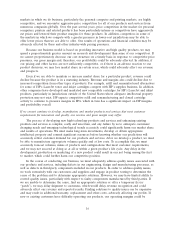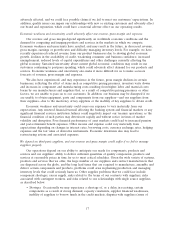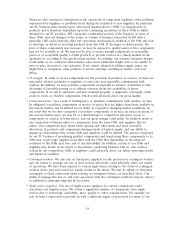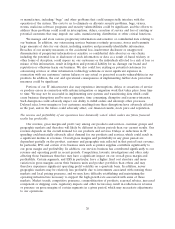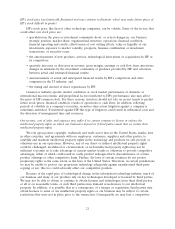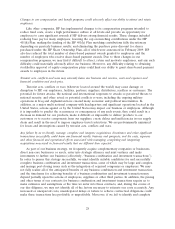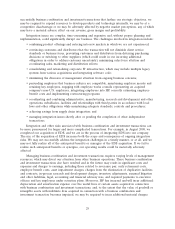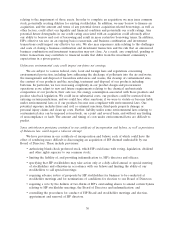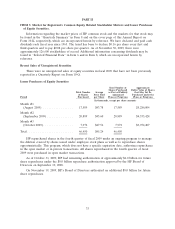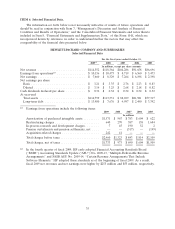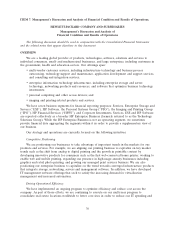HP 2009 Annual Report Download - page 33
Download and view the complete annual report
Please find page 33 of the 2009 HP annual report below. You can navigate through the pages in the report by either clicking on the pages listed below, or by using the keyword search tool below to find specific information within the annual report.accuracy, may damage our business by affecting our ability to compete for new contracts. If our
customer contracts are terminated, if we are suspended from government work, or if our ability to
compete for new contracts is adversely affected, we could suffer a material reduction in expected
revenue.
We make estimates and assumptions in connection with the preparation of HP’s Consolidated Financial
Statements, and any changes to those estimates and assumptions could have a material adverse effect on
our results of operations.
In connection with the preparation of HP’s Consolidated Financial Statements, we use certain
estimates and assumptions based on historical experience and other factors. Our most critical
accounting estimates are described in ‘‘Management’s Discussion and Analysis of Financial Condition
and Results of Operations’’ in this report. In addition, as discussed in Note 18 to the Consolidated
Financial Statements, we make certain estimates, including decisions related to provisions for legal
proceedings and other contingencies. While we believe that these estimates and assumptions are
reasonable under the circumstances, they are subject to significant uncertainties, some of which are
beyond our control. Should any of these estimates and assumptions change or prove to have been
incorrect, it could have a material adverse effect on our results of operations.
Unanticipated changes in HP’s tax provisions, the adoption of a new U.S. tax legislation or exposure to
additional income tax liabilities could affect our profitability.
We are subject to income taxes in the United States and numerous foreign jurisdictions. Our tax
liabilities are affected by the amounts we charge for inventory, services, licenses, funding and other
items in intercompany transactions. We are subject to ongoing tax audits in various jurisdictions. Tax
authorities may disagree with our intercompany charges, cross-jurisdictional transfer pricing or other
matters and assess additional taxes. We regularly assess the likely outcomes of these audits in order to
determine the appropriateness of our tax provision. However, there can be no assurance that we will
accurately predict the outcomes of these audits, and the amounts ultimately paid upon resolution of
audits could be materially different from the amounts previously included in our income tax expense
and therefore could have a material impact on our tax provision, net income and cash flows. In
addition, our effective tax rate in the future could be adversely affected by changes to our operating
structure, changes in the mix of earnings in countries with differing statutory tax rates, changes in the
valuation of deferred tax assets and liabilities, changes in tax laws and the discovery of new information
in the course of our tax return preparation process. In particular, the carrying value of deferred tax
assets, which are predominantly in the United States, is dependent on our ability to generate future
taxable income in the United States. In addition, President Obama’s administration has recently
announced proposals for a new U.S. tax legislation that, if adopted, could adversely affect our tax rate.
Any of these changes could affect our profitability.
Our sales cycle makes planning and inventory management difficult and future financial results less
predictable.
In some of our segments, our quarterly sales often have reflected a pattern in which a
disproportionate percentage of each quarter’s total sales occur towards the end of such quarter. This
uneven sales pattern makes prediction of revenue, earnings, cash flow from operations and working
capital for each financial period difficult, increases the risk of unanticipated variations in quarterly
results and financial condition and places pressure on our inventory management and logistics systems.
If predicted demand is substantially greater than orders, there will be excess inventory. Alternatively, if
orders substantially exceed predicted demand, we may not be able to fulfill all of the orders received in
the last few weeks of each quarter. Other developments late in a quarter, such as a systems failure,
component pricing movements, component shortages or global logistics disruptions, could adversely
26


